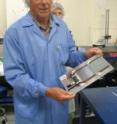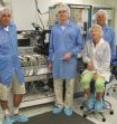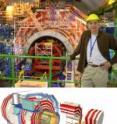UC Santa Barbara has key role in Large Hadron Collider project
Earlier today, some 300 feet below the Earth's surface, in a circular tunnel so extensive that it travels from Switzerland into France and back again, scientists at the Large Hadron Collider (LHC) at the European Organization for Nuclear Research (CERN) in Geneva fired the first beams of protons that they hope will eventually produce history-making science. A contingent of more than 40 faculty members, graduate students, postdoctoral researchers, engineers, technicians, and undergraduates from UC Santa Barbara have worked for eight years to help construct the experimental apparatus. The UCSB group is part of an international effort that is now embarking on a 15-year quest to try to answer fundamental questions about the universe.
The startup of the LHC marked a milestone for the UCSB particle physics program. The group has played a key role in constructing one of four major experiments now in place — the Compact Muon Solenoid (CMS), a complex array of instruments for detecting subatomic particles. The device weighs more than 12,000 tons and is as tall as a four-story building.
UCSB's team is led by four members of its experimental high-energy physics faculty. Professor Joseph Incandela has been in Switzerland for the past year, shepherding the CMS experiment as deputy physics coordinator. Shuttling back and forth between Santa Barbara and Switzerland have been professors Claudio Campagnari, Jeffrey Richman, and David Stuart. The faculty members are unanimous in their praise for CERN's monumental effort in building the LHC, the world's largest particle accelerator.
"This is frontier science on a grand international scale," says Michael Witherell, vice chancellor for research at UCSB, of the university's role in the LHC. "It is remarkable how many important contributions our faculty and students have already made to this historic experiment."
UCSB's initial role in the CMS experiment was to build part of the particle tracking system, which measures the paths of particles produced in the proton-proton collisions.
By combining the information from all parts of the CMS detector, scientists can reconstruct an electronic image of what happens in each collision.
According to Incandela, UCSB delivered 2.5 million channels of particle detectors, which were meticulously constructed in cleanrooms in the university's physics department. The detectors were of "extremely high quality," Incandela says, noting a failure rate of only 0.02 percent. "Our group then helped assemble and test the detectors at CERN."
CMS is a huge project involving thousands of scientists from all over the world. Many U.S. universities have contributed time and staff to CMS and other LHC experiments. UCSB scientists and other staff members say they are proud to have played a leading role in the construction of the detector's tracking system. One-third of this enormous system was assembled and tested at UCSB. The high-energy physics faculty members say that the contributions of many UCSB students and staff over the past eight years were essential. "I think it's pretty extraordinary what the group has done," says Richman.
"This is a fantastic educational opportunity for our students," Richman says. Now that construction of the detector is complete, the focus of the UCSB group has shifted to preparations for analyzing the vast quantity of data that will start to pour out of the detector in a few months. Eventually, about 1 billion collisions per second will be electronically imaged by the detector. Of these, several hundred images per second will be recorded for detailed study.
The UCSB group is funded primarily by the U.S. Department of Energy, with additional support from the National Science Foundation. "The university helps us in many ways, but the main funding for the group's operations is provided by the Department of Energy's Office of Science," Richman says. "They have treated us extremely well and we appreciate it."
Until now, the world's biggest accelerator has been at Fermi National Accelerator Laboratory, also known as Fermilab, near Chicago, Ill. Witherell was director of Fermilab from 1999 to 2005, when he returned to lead UCSB's research administration. He has strong ties to the CMS experiment. "I spent my life doing particle physics research, and I am anticipating great discoveries from CMS," Witherell says.
The turning on of the LHC represents the start of a scientific program that will address some of the most pressing questions in particle physics and cosmology. The UCSB group has formed several teams to analyze the mountain of data that will be generated.
"CMS is a powerful and versatile detector, which can be used to perform many different experiments," Stuart explains. Noting that high-energy collisions can create sub-atomic particles from energy, Stuart adds, "If we are lucky, we may discover particles that would explain the dark matter inferred by astrophysicists from observations of galactic motions. This would be really exciting."
Particle physicists have been searching for a deep understanding of matter and energy, including an explanation for the origin of mass, which could be found if physicists are able to discover the so-called "Higgs boson,'' the particle that causes other particles to have mass. Other theorists have speculated that the LHC could even reveal new spatial dimensions with properties vastly different from those with which we are familiar.
With so many possibilities for discovery, the anticipation for the startup of this program has been enormous. "It's great that the machine has turned on," Campagnari says. "I don't think we're going to turn it on in September and make discoveries in October. But discoveries could start coming soon and could happen over many years."
"This is a historic undertaking, and it is great to be part of it," Incandela says. "We are working with some of the top particle physicists of our era to prepare for what we might see. The range of possibilities is broad, but the most incredible aspect of this program is that whatever we see will be very important to our understanding of the basic forces of nature."
Source: University of California - Santa Barbara
Other sources
- Hackers mock collider computer securityfrom UPISat, 13 Sep 2008, 14:21:08 UTC
- News quiz: the news from Switzerlandfrom The Guardian - ScienceThu, 11 Sep 2008, 14:28:07 UTC


